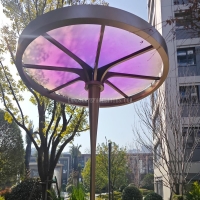Welcome to the website for landscape facilities products and knowledge.
What are the best ways to design a landscape bar counter for easy access to outdoor serving trays?
Designing a landscape bar counter that seamlessly integrates with outdoor serving requirements demands thoughtful planning and strategic execution. The ideal outdoor bar should not only serve as an entertainment hub but also facilitate effortless access to serving trays, enhancing both functionality and guest experience. Here are the most effective approaches to achieve this harmonious balance.
First, incorporate dedicated tray storage compartments within the bar structure. These specialized niches, preferably located beneath the countertop or within easy reach of the serving area, keep trays organized and readily accessible. Consider installing slide-out shelves or vertical dividers to accommodate different tray sizes while protecting them from environmental elements. This integrated storage solution minimizes clutter and ensures servers can quickly grab trays without interrupting the flow of service.
The countertop overhang plays a crucial role in tray accessibility. Extend the counter surface by 12-16 inches to create a comfortable serving ledge where trays can be temporarily placed during loading and unloading. This design feature allows staff or hosts to arrange items on trays without occupying the main preparation area. For enhanced functionality, incorporate a lower-level shelf beneath this overhang specifically designed for trays in transit, creating a efficient loading zone.
Strategic material selection significantly impacts both durability and functionality. Choose weather-resistant materials like teak, stainless steel, or composite decking that can withstand outdoor conditions while providing smooth surfaces for tray movement. The counter surface should be slightly textured to prevent slipping yet smooth enough to allow trays to slide easily when necessary. Incorporate drainage channels in the design to prevent water accumulation that could interfere with tray handling.
Ergonomics should guide the overall layout. Position the tray storage and access points at hip level (approximately 30-36 inches from the ground) to minimize bending and reaching. This height optimization reduces strain during frequent tray retrieval and return. For larger outdoor bars, consider creating multiple access points around the perimeter to prevent congestion during busy gatherings.
Integrate functional accessories that enhance tray management. Install hooks along the bar sides for hanging smaller serving trays, and incorporate retractable tray tables that can be deployed when needed and concealed when not in use. Magnetic strips can secure metal trays in windy conditions, while built-in tray racks keep various sizes organized and accessible.
The pathway design around the bar significantly affects tray accessibility. Maintain a clear circulation route of at least 36 inches width around all serving areas to allow comfortable movement with loaded trays. Surface this pathway with smooth, level materials like flagstone or poured concrete to prevent tripping hazards when carrying trays.
Lighting plays an often-overlooked role in functional bar design. Install targeted lighting above tray storage areas and along serving paths to ensure visibility during evening events. LED strip lighting under counters or along pathways helps identify tray locations while creating an inviting ambiance.
Finally, consider the integration of mobile serving stations that complement the fixed bar structure. These portable units can extend serving capacity during large events and provide additional tray staging areas. Design them to match the main bar's aesthetics while ensuring easy movement across your outdoor surfaces.
By implementing these design strategies, your landscape bar counter will become not just a beautiful outdoor feature but a highly functional serving station that makes tray access effortless and efficient. The result is an outdoor entertainment space that works as beautifully as it looks, enhancing both the hosting experience and guest enjoyment through thoughtful, practical design solutions.
Related search:

Recommendation
Metal frame with gradient color acrylic combined with high-end shading landscape facilities